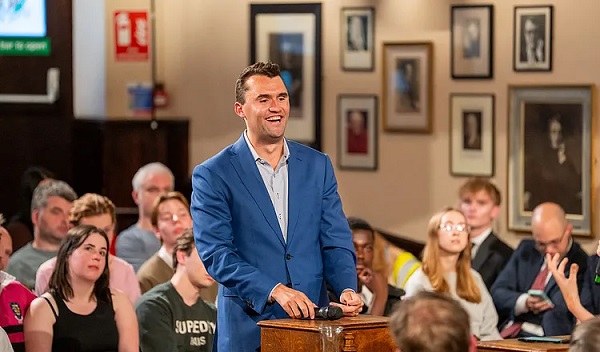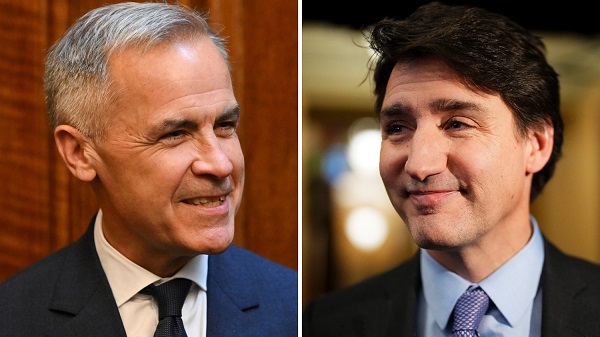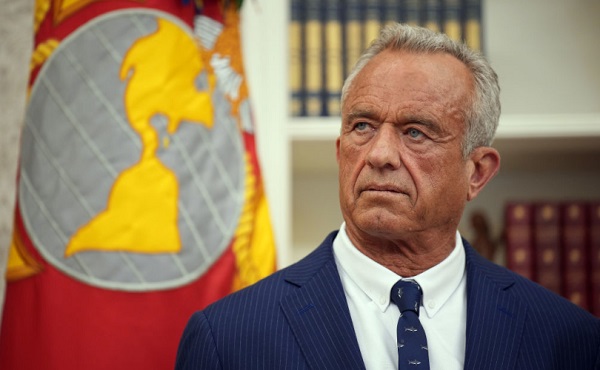Frontier Centre for Public Policy
Charlie Kirk Fought A Progressive Ideology That Punishes Truth

From the Frontier Centre for Public Policy
By Collin May
Kirk didn’t fight the left or right—he fought a system that punishes dissent and fears honest debate.
Charlie Kirk’s assassination wasn’t just a tragedy—it was a chilling reminder of what happens when postmodern orthodoxy becomes power. I didn’t know him personally, but I know the battle he was fighting—and why it matters now more than ever.
The closest I came to a connection with the prolific activist is that I work with his family doctor—a reformist Muslim from Arizona—as a member of the Clarity Coalition, an organization that brings together Jews, Muslims, Hindus, Christians, atheists and humanists united by a common purpose: defending liberal values and free speech.
When I saw my medical friend last Friday on a Zoom meeting, it was clear he was heartbroken by Kirk’s death. There’s some irony in the fact that a man who has devoted his life to bridging the Muslim and Western worlds so deeply mourns his patient and friend, an unwavering and devout Christian.
And yet, when it comes to Charlie Kirk, I’m not only interested in a life needlessly lost but in who he was as a public figure. I didn’t follow his work closely, though there are some standout facts most of us know.
First, he was relatively young at 31. Second, he was close to the Trump team and often credited with attracting younger voters to the septuagenarian president. Third, he was the founder of Turning Point USA—a conservative American youth organization known for its confrontational campus events. And fourth, and here’s where I want to focus, he took the fight against ideological orthodoxy to the heart of the beast: the university campus.
As someone who’s had his own run-ins with the leftist dogma of higher education, I’ll admit that Kirk was a braver man than me. He charged into the ideological lion’s den—students and professors alike—armed with clarity, conviction and a few sharpened arguments. And more often than not, he managed to expose the assumptions beneath the slogans.
Some argue he merely deployed well-rehearsed intellectual parlour tricks—simplified narratives about the modern left that gloss over deeper social issues. That criticism, though, is telling, especially coming from disciples of postmodernism. (For clarity, postmodernism is an academic movement that rejects objectivity and questions traditional social structures—including science, morality and Western institutions.) There’s some dry comedy in that.
After all, these are the same disciples of postmodernism, neofeminism and anti-racism who insist that truth is a myth and that liberal democracy is little more than a mask for systemic oppression. If everything is power, then why scold Kirk for using rhetorical jiu-jitsu against the very rules our postmodern overlords laid down?
Of course, there was more to Kirk than ironic pushback. The worldview he challenged has become dominant across much of the West—the view that liberal principles like individual freedom, equality under law, private property and free speech have failed.
I have some sympathy for this view, and I suspect Kirk did too. Liberalism has always contended with internal critics, not just defenders of tradition and privilege, but radicals who argue that individual freedom obstructs true equality and liberation.
This internal critique is not new—but today, it’s become embedded. Our universities, corporations and governments—in the U.S. and increasingly in Canada—drink deeply from the well of this anti-Western, anti-liberal orthodoxy.
But as Nietzsche warned, we can’t be like crabs walking backwards into the sand. We must face liberalism’s failures head-on. And for conservatives still clinging to the dusty virtues of the old order—the so-called “principled conservatives”—I’d suggest Nietzsche’s warning applies to you too. The past is not a cure.
Here’s the real conundrum: our postmodern uniformity of thought—the very thing that set out to challenge power—has itself become the power. It hasn’t transcended the dynamics it claims to critique. It has replicated them. To question the prevailing dogmas now is to risk cancellation—or worse. On a university campus, it can get you killed.
Charlie Kirk, I think, understood that. He wasn’t trying to rewind history to some idealized liberal past. Nor was he a garden-variety conservative or, in the fevered imagination of the left, a fascist.
No—he was something different. A post-postmodern. That is, someone rejecting both liberal complacency and the stale deconstructions of the academic left. By confronting them where they were strongest, he called out the ideological crabs scuttling through the moribund academy.
If there’s a way to honour his legacy, perhaps it lies in the universities he challenged. Maybe they’ll find the courage to endow chairs and scholarships dedicated to what comes next: to seriously and critically explore what follows after decades of disillusionment and intellectual laziness.
We’d do well to have that conversation here in Canada, too, before more intellectual dissent becomes dangerous. Because, like it or not, in the shadow of Charlie Kirk’s death, we are all post-postmoderns now.
Collin May is a Senior Fellow with the Frontier Centre for Public Policy, a lawyer, and Adjunct Lecturer in Community Health Sciences at the University of Calgary, with degrees in law (Dalhousie University), a Masters in Theological Studies (Harvard) and a Diplôme d ’études approfondies (École des hautes études, Paris).
Business
Carney’s Deficit Numbers Deserve Scrutiny After Trudeau’s Forecasting Failures

From the Frontier Centre for Public Policy
By Conrad Eder
Frontier Centre for Public Policy study reveals a decade of inflated Liberal forecasts—a track record that casts a long shadow over Carney’s first budget
The Frontier Centre for Public Policy has released a major new study revealing that the Trudeau government’s federal budget forecasts from 2016 to 2025 were consistently inaccurate and biased — a record that casts serious doubt on the projections in Prime Minister Mark Carney’s first budget.
Carney’s 2025–26 federal budget forecasts a $78.3-billion deficit — twice the size projected last year and four times what was forecast in Budget 2022. But if recent history is any guide, Canadians have good reason to question whether even this ballooning deficit reflects fiscal reality.
The 4,000-word study, Measuring Federal Budgetary Balance Forecasting Accuracy and Bias, by Frontier Centre policy analyst Conrad Eder, finds that forecast accuracy collapsed after the Trudeau government took office:
- Current-year forecasts were off by an average of $22.9 billion, or one per cent of GDP.
- Four-year forecasts missed the mark by an average of $94.4 billion, or four per cent of GDP.
- Long-term projections consistently overstated Canada’s fiscal health, showing a clear optimism bias.
Eder’s analysis shows that every three- and four-year forecast under Trudeau predicted a stronger financial position than what actually occurred, masking the true scale of deficits and debt accumulation. The study concludes that this reflects a systemic optimism bias, likely rooted in political incentives: short-term optics with no regard to long-term consequences.
“With Prime Minister Carney now setting Canada’s fiscal direction, it’s critical to assess his projections in light of this track record,” said Eder. “The pattern of bias and inaccuracy under previous Liberal governments gives reason to doubt the credibility of claims that deficits will shrink over time. Canadians deserve fiscal forecasts that are credible and transparent — not political messaging disguised as economic planning.”
The study warns that persistent optimism bias erodes fiscal accountability, weakens public trust and limits citizens’ ability to hold government to account — a threat to both economic sustainability and democratic transparency.
Business
Capital Flight Signals No Confidence In Carney’s Agenda

From the Frontier Centre for Public Policy
By Jay Goldberg
Between bad trade calls and looming deficits, Canada is driving money out just when it needs it most
Canadians voted for relative continuity in April, but investors voted with their wallets, moving $124 billion out of the country.
According to the National Bank, Canadian investors purchased approximately $124 billion in American securities between February and July of this year. At the same time, foreign investment in Canada dropped sharply, leaving the country with a serious hole in its capital base.
As Warren Lovely of National Bank put it, “with non-resident investors aloof and Canadians adding foreign assets, the country has suffered a major capital drain”—one he called “unprecedented.”
Why is this happening?
One reason is trade. Canada adopted one of the most aggressive responses to U.S. President Donald Trump’s tariff agenda. Former prime minister Justin Trudeau imposed retaliatory tariffs on the United States and escalated tensions further by targeting goods covered under the Canada–United States–Mexico Agreement (CUSMA), something even the Trump administration avoided.
The result was punishing. Washington slapped a 35 per cent tariff on non-CUSMA Canadian goods, far higher than the 25 per cent rate applied to Mexico. That made Canadian exports less competitive and unattractive to U.S. consumers. The effects rippled through industries like autos, agriculture and steel, sectors that rely heavily on access to U.S. markets. Canadian producers suddenly found themselves priced out, and investors took note.
Recognizing the damage, Prime Minister Mark Carney rolled back all retaliatory tariffs on CUSMA-covered goods this summer in hopes of cooling tensions. Yet the 35 per cent tariff on non-CUSMA Canadian exports remains, among the highest the U.S. applies to any trading partner.
Investors saw the writing on the wall. They understood Trudeau’s strategy had soured relations with Trump and that, given Canada’s reliance on U.S. trade, the United States would inevitably come out on top. Parking capital in U.S. securities looked far safer than betting on Canada’s economy under a government playing a weak hand.
The trade story alone explains much of the exodus, but fiscal policy is another concern. Interim Parliamentary Budget Officer Jason Jacques recently called Ottawa’s approach “stupefying” and warned that Canada risks a 1990s-style fiscal crisis if spending isn’t brought under control. During the 1990s, ballooning deficits forced deep program cuts and painful tax hikes. Interest rates soared, Canada’s debt was downgraded and Ottawa nearly lost control of its finances. Investors are seeing warning signs that history could repeat itself.
After months of delay, Canadians finally saw a federal budget on Nov. 4. Jacques had already projected a deficit of $68.5 billion when he warned the outlook was “unsustainable.” National Bank now suggests the shortfall could exceed $100 billion. And that doesn’t include Carney’s campaign promises, such as higher defence spending, which could add tens of billions more.
Deficits of that scale matter. They can drive up borrowing costs, leave less room for social spending and undermine confidence in the country’s long-term fiscal stability. For investors managing pensions, RRSPs or business portfolios, Canada’s balance sheet now looks shaky compared to a U.S. economy offering both scale and relative stability.
Add in high taxes, heavy regulation and interprovincial trade barriers, and the picture grows bleaker. Despite decades of promises, barriers between provinces still make it difficult for Canadian businesses to trade freely within their own country. From differing trucking regulations to restrictions on alcohol distribution, these long-standing inefficiencies eat away at productivity. When combined with federal tax and regulatory burdens, the environment for growth becomes even more hostile.
The Carney government needs to take this unprecedented capital drain seriously. Investors are not acting on a whim. They are responding to structural problems—ill-advised trade actions, runaway federal spending and persistent barriers to growth—that Ottawa has yet to fix.
In the short term, that means striking a deal with Washington to lower tariffs and restore confidence that Canada can maintain stable access to U.S. markets. It also means resisting the urge to spend Canada into deeper deficits when warning lights are already flashing red. Over the long term, Ottawa must finally tackle high taxes, cut red tape and eliminate the bureaucratic obstacles that stand in the way of economic growth.
Capital has choices. Right now, it is voting with its feet, and with its dollars, and heading south. If Canada wants that capital to come home, the government will have to earn it back.
Jay Goldberg is a fellow with the Frontier Centre for Public Policy.
-

 Alberta2 days ago
Alberta2 days agoTell the Province what you think about 120 km/h speed limit on divided highways
-

 Energy17 hours ago
Energy17 hours agoThawing the freeze on oil and gas development in Treaty 8 territory
-

 Alberta2 days ago
Alberta2 days agoAlberta’s number of inactive wells trending downward
-

 National1 day ago
National1 day agoNew Canadian bill would punish those who deny residential indigenous schools deaths claims
-

 Business2 days ago
Business2 days agoBill Gates Gets Mugged By Reality
-

 Business17 hours ago
Business17 hours agoWhat Pelosi “earned” after 37 years in power will shock you
-

 Censorship Industrial Complex2 days ago
Censorship Industrial Complex2 days agoSchool Cannot Force Students To Use Preferred Pronouns, US Federal Court Rules
-

 Health1 day ago
Health1 day agoRFK Jr. urges global health authorities to remove mercury from all vaccines




